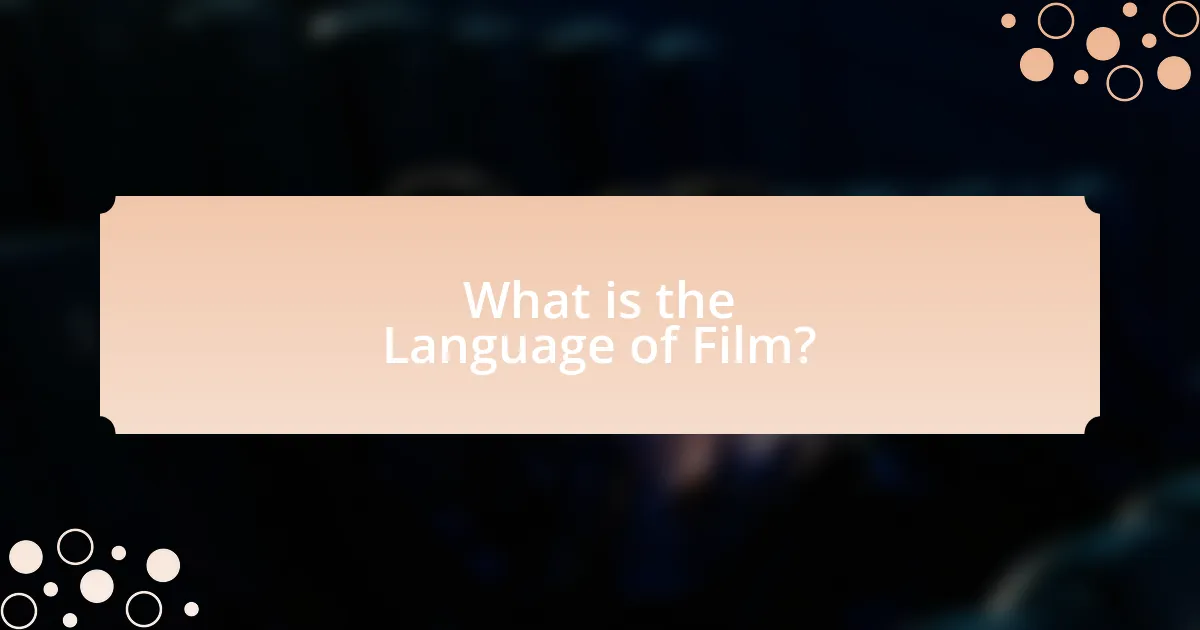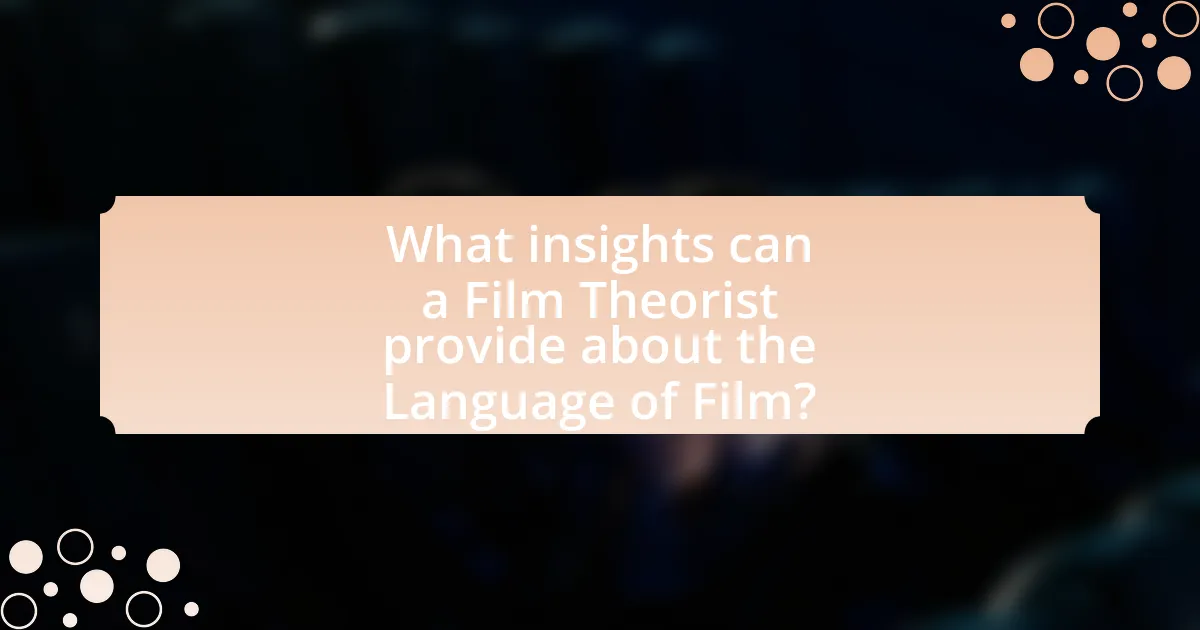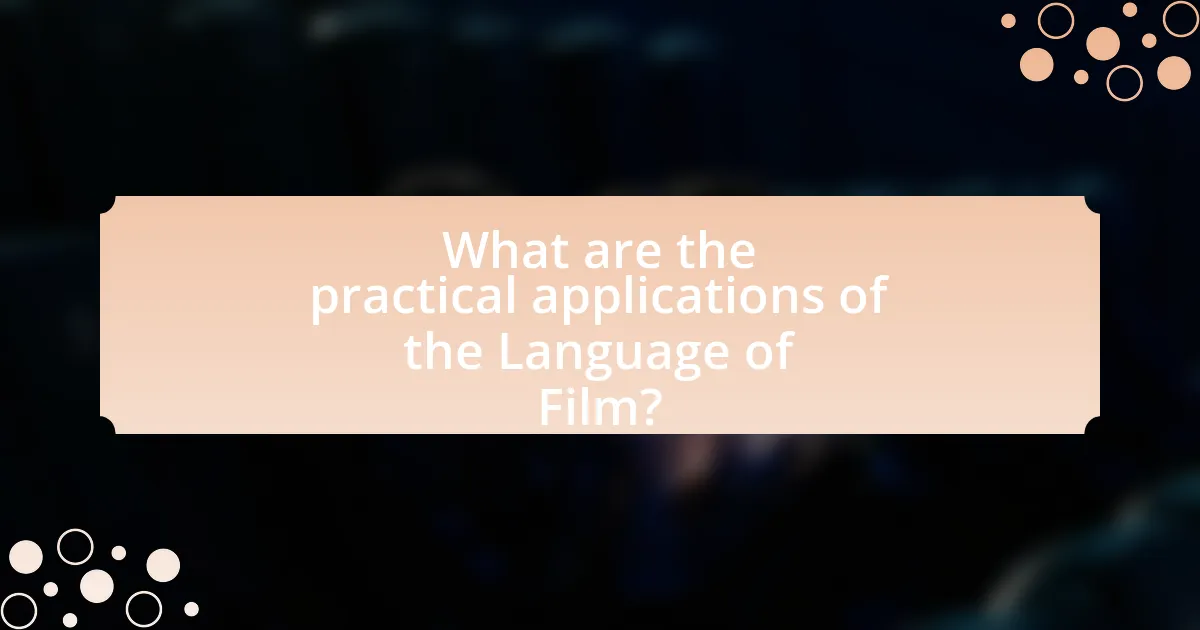The article titled “The Language of Film: An Interview with a Film Theorist” explores the intricate visual and auditory elements that constitute the language of film, including cinematography, editing, sound design, and mise-en-scène. It emphasizes how these components work together to convey meaning and evoke emotions in cinematic storytelling. Key insights from film theorists highlight the importance of understanding these elements for deeper audience engagement and interpretation. Additionally, the article addresses common misconceptions about film language and offers practical tips for enhancing film analysis and appreciation.

What is the Language of Film?
The language of film refers to the visual and auditory elements that convey meaning and emotion in cinematic storytelling. This includes aspects such as cinematography, editing, sound design, and mise-en-scène, which work together to create a narrative and evoke responses from the audience. For instance, the use of close-ups can intensify emotional engagement, while specific editing techniques can manipulate time and space, shaping the viewer’s perception of the story. These elements are foundational in film theory, as articulated by scholars like David Bordwell and Kristin Thompson, who emphasize the importance of these components in understanding how films communicate.
How does the Language of Film communicate ideas and emotions?
The language of film communicates ideas and emotions through visual storytelling, sound design, and editing techniques. Visual elements such as cinematography, color palettes, and composition convey mood and themes, while sound elements like music and dialogue enhance emotional resonance. For example, the use of close-up shots can evoke intimacy or tension, while a specific color scheme can symbolize particular emotions, as seen in films like “The Sixth Sense,” where the color red signifies danger. Editing techniques, such as pacing and transitions, also play a crucial role in shaping audience reactions, as demonstrated in the rapid cuts of action sequences that create excitement or suspense. These combined elements form a cohesive language that filmmakers use to express complex narratives and evoke emotional responses from viewers.
What are the key elements that constitute the Language of Film?
The key elements that constitute the Language of Film include cinematography, editing, sound, mise-en-scène, and narrative structure. Cinematography involves the visual composition and camera movement, which shapes how viewers perceive the story. Editing refers to the arrangement of shots, influencing pacing and continuity, while sound encompasses dialogue, music, and sound effects that enhance emotional engagement. Mise-en-scène includes the arrangement of scenery, props, and actors, contributing to the film’s overall aesthetic and atmosphere. Narrative structure dictates the organization of the story, guiding audience understanding and emotional response. Each of these elements works together to create a cohesive cinematic experience, as evidenced by their critical roles in successful films across various genres.
How do visual storytelling techniques enhance the Language of Film?
Visual storytelling techniques enhance the Language of Film by using imagery, composition, and movement to convey emotions and narratives without relying solely on dialogue. These techniques allow filmmakers to create a visual language that communicates themes and character development effectively. For instance, the use of color palettes can evoke specific feelings; warm colors may suggest comfort or passion, while cool colors can indicate sadness or detachment. Additionally, camera angles and framing can influence audience perception, guiding viewers’ attention to crucial elements of the story. Research indicates that visual elements can significantly impact audience engagement and emotional response, reinforcing the idea that visual storytelling is integral to cinematic expression.
Why is understanding the Language of Film important for audiences?
Understanding the Language of Film is crucial for audiences because it enhances their ability to interpret and engage with cinematic narratives. This comprehension allows viewers to recognize visual storytelling techniques, such as cinematography, editing, and sound design, which shape their emotional and intellectual responses to films. Research indicates that audiences who grasp these elements are more likely to appreciate the artistic intentions behind a film, leading to a deeper connection with the material. For instance, a study published in the Journal of Film Studies highlights that viewers who understand film language can analyze character motivations and thematic depth more effectively, enriching their overall viewing experience.
How does the Language of Film influence viewer perception?
The language of film influences viewer perception by utilizing visual and auditory elements to convey meaning and evoke emotions. Cinematic techniques such as camera angles, lighting, sound design, and editing shape how audiences interpret narratives and characters. For example, a high-angle shot can make a character appear vulnerable, while a low-angle shot can convey power. Research by Bordwell and Thompson in “Film Art: An Introduction” highlights that these techniques guide viewers’ emotional responses and understanding of the story, demonstrating that the language of film is a powerful tool in shaping perception.
What role does cultural context play in interpreting the Language of Film?
Cultural context significantly influences the interpretation of the Language of Film by shaping viewers’ perceptions, emotions, and understanding of narrative elements. For instance, cultural norms, values, and historical backgrounds inform how audiences interpret symbols, character motivations, and thematic messages within films. Research indicates that films often reflect the socio-political climate of their time, which can alter audience reception; for example, a film addressing social justice may resonate differently in cultures with varying levels of awareness or activism regarding those issues. Thus, cultural context acts as a lens through which the Language of Film is understood, affecting both individual and collective interpretations.

What insights can a Film Theorist provide about the Language of Film?
A Film Theorist can provide insights into the Language of Film by analyzing how visual and auditory elements convey meaning and emotion. They explore the use of cinematography, editing, sound design, and narrative structure to understand how these components work together to create a cohesive storytelling experience. For instance, the concept of “montage” illustrates how editing can manipulate time and space to evoke specific responses from the audience, as demonstrated in Sergei Eisenstein’s films. Additionally, a Film Theorist may examine how genre conventions shape audience expectations and interpretations, highlighting the role of cultural context in film language.
How does a Film Theorist define the Language of Film?
A Film Theorist defines the Language of Film as a system of visual and auditory signs that convey meaning and emotion to the audience. This language encompasses elements such as cinematography, editing, sound, and mise-en-scène, which work together to create a narrative and evoke responses. For instance, the use of close-ups can intensify emotional engagement, while editing techniques like cross-cutting can build tension and manipulate time. Theoretical frameworks, such as those proposed by theorists like Sergei Eisenstein, emphasize how these elements interact to form a cohesive cinematic language that communicates complex ideas and feelings beyond mere dialogue.
What theories are most influential in understanding the Language of Film?
The most influential theories in understanding the Language of Film include Semiotics, Structuralism, and Auteur Theory. Semiotics, as proposed by theorists like Ferdinand de Saussure, emphasizes the study of signs and symbols in film, illustrating how visual elements convey meaning. Structuralism, influenced by Claude Lévi-Strauss, analyzes the underlying structures that shape narratives and genres, revealing how films communicate through established conventions. Auteur Theory, championed by François Truffaut, posits that the director’s vision is central to a film’s identity, suggesting that personal style and thematic consistency are key to understanding cinematic language. These theories collectively provide a framework for analyzing how films communicate complex ideas and emotions.
How do Film Theorists analyze cinematic techniques?
Film theorists analyze cinematic techniques by examining elements such as cinematography, editing, sound, and mise-en-scène to understand how they contribute to storytelling and audience perception. They utilize frameworks from various theoretical perspectives, including formalism, realism, and psychoanalysis, to dissect how these techniques evoke emotions, create meaning, and influence viewer engagement. For instance, the use of close-ups can intensify emotional connection, while editing rhythms can manipulate narrative pacing. This analytical approach is supported by historical examples, such as Sergei Eisenstein’s montage theory, which illustrates how editing can create meaning beyond individual shots.
What are the common misconceptions about the Language of Film?
Common misconceptions about the Language of Film include the belief that film is merely a visual medium, that it lacks a structured grammar, and that it is universally understood without cultural context. Film is not just about images; it combines visual elements, sound, and editing to create meaning, similar to how language uses words and syntax. Additionally, film has its own grammar, including shot composition, editing techniques, and narrative structure, which filmmakers use to convey messages effectively. Furthermore, understanding film often requires knowledge of cultural references and historical context, as interpretations can vary significantly across different audiences.
Why do some people underestimate the complexity of the Language of Film?
Some people underestimate the complexity of the Language of Film because they perceive it as merely a form of entertainment rather than a sophisticated medium of communication. This perception often stems from a lack of understanding of the various elements that contribute to film language, such as cinematography, editing, sound design, and narrative structure. Research indicates that film employs a unique syntax and grammar that conveys meaning beyond dialogue, similar to how literature uses literary devices. For instance, a study by Bordwell and Thompson in “Film Art: An Introduction” highlights how visual storytelling techniques can evoke emotions and convey themes, demonstrating that film is a complex art form deserving of deeper analysis.
How can these misconceptions affect film appreciation?
Misconceptions can significantly hinder film appreciation by limiting viewers’ understanding of cinematic techniques and narratives. When audiences hold incorrect beliefs about film elements, such as the role of editing or sound design, they may overlook the artistry involved, leading to a superficial engagement with the medium. For instance, research indicates that viewers who misunderstand the purpose of non-linear storytelling often struggle to grasp the thematic depth of films that employ this technique, resulting in a diminished viewing experience. This lack of comprehension can prevent audiences from fully appreciating the emotional and intellectual layers that filmmakers intend to convey.

What are the practical applications of the Language of Film?
The practical applications of the Language of Film include storytelling, visual communication, and emotional engagement. Storytelling is enhanced through cinematic techniques such as editing, cinematography, and sound design, which help convey narratives effectively. Visual communication is achieved by using symbols, imagery, and visual metaphors that resonate with audiences, allowing filmmakers to express complex ideas succinctly. Emotional engagement is fostered through the use of music, pacing, and character development, which evoke specific feelings and reactions from viewers. These applications are evident in various film genres, from documentaries that inform to dramas that connect on a personal level, demonstrating the Language of Film’s versatility in conveying messages and experiences.
How can filmmakers effectively utilize the Language of Film?
Filmmakers can effectively utilize the Language of Film by mastering visual storytelling techniques, such as composition, editing, and sound design. These elements work together to convey emotions, themes, and narratives without relying solely on dialogue. For instance, the use of close-ups can intensify emotional connections, while editing can manipulate time and pacing to enhance storytelling. Historical examples, such as Alfred Hitchcock’s use of suspense through editing in “Psycho,” demonstrate how these techniques can create tension and engage audiences. By understanding and applying these principles, filmmakers can create compelling narratives that resonate with viewers on multiple levels.
What techniques should filmmakers focus on to enhance storytelling?
Filmmakers should focus on techniques such as character development, visual storytelling, and pacing to enhance storytelling. Character development allows audiences to connect emotionally with the narrative, as seen in films like “The Godfather,” where complex characters drive the plot. Visual storytelling, through cinematography and composition, conveys themes and emotions without dialogue, exemplified in “Blade Runner,” where visuals establish mood and context. Pacing, the rhythm of the narrative, maintains audience engagement; for instance, “Mad Max: Fury Road” uses relentless pacing to create tension and excitement. These techniques are essential for creating compelling and immersive cinematic experiences.
How can understanding the Language of Film improve audience engagement?
Understanding the Language of Film enhances audience engagement by enabling viewers to interpret visual and auditory cues effectively. This comprehension allows audiences to connect emotionally with the narrative, as they recognize techniques such as cinematography, editing, and sound design that evoke specific feelings. Research indicates that films employing strong visual storytelling elements can increase viewer retention and emotional response, as evidenced by studies showing that audiences are more likely to remember films that utilize effective visual metaphors and motifs. Thus, a deeper grasp of film language not only enriches the viewing experience but also fosters a more profound connection between the audience and the film’s themes.
What tips can enhance one’s understanding of the Language of Film?
To enhance one’s understanding of the Language of Film, one should actively analyze films by paying attention to visual storytelling elements such as composition, lighting, and camera angles. Engaging with film theory literature, such as “Film Theory: An Introduction” by Robert Stam, provides foundational knowledge about cinematic techniques and their meanings. Additionally, watching films from various genres and cultures broadens perspective and appreciation for different narrative styles and techniques, reinforcing the understanding of how film communicates ideas and emotions.
How can viewers analyze films more critically?
Viewers can analyze films more critically by actively engaging with the film’s elements such as narrative structure, cinematography, sound design, and character development. This engagement allows viewers to understand the filmmaker’s intentions and the cultural context of the film. For instance, analyzing how a film’s editing influences pacing can reveal deeper emotional impacts, as seen in films like “Birdman,” where continuous shots create a sense of urgency. Additionally, exploring themes and motifs can enhance comprehension; for example, the recurring use of color in “The Grand Budapest Hotel” signifies emotional states and character arcs. By applying these analytical techniques, viewers can gain a richer understanding of the film’s artistry and message.
What resources are available for learning about the Language of Film?
Books, online courses, and film analysis websites are key resources for learning about the Language of Film. Notable books include “Film Language: A Semiotics of the Cinema” by Christian Metz, which explores the signs and codes used in film, and “The Visual Story” by Bruce Block, which discusses visual structure in storytelling. Online platforms like Coursera and MasterClass offer courses taught by industry professionals, providing practical insights into film techniques and theory. Additionally, websites such as Film School Rejects and No Film School provide articles and tutorials that analyze film language and techniques, making them accessible for learners at all levels.